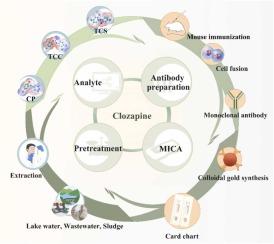Multiplex immunochromatographic assay for simultaneous detection of triclosan, triclocarban and chlorophene in environmental samples
IF 11.3
1区 环境科学与生态学
Q1 ENGINEERING, ENVIRONMENTAL
引用次数: 0
Abstract
Triclosan (TCS), triclocarban (TCC), and chlorophene (CP) are widely used antimicrobial agents with persistent environmental residues, posing potential ecological and health risks. Thus, developing a sensitive, rapid on-site screening method is highly significant. In this study, computer simulation was first employed to screen the haptens of TCS, TCC and CP to prepare highly specific and high affinity monoclonal antibodies with half-maximal inhibitory concentrations of 1.044, 0.964, and 1.704 ng/mL, respectively. Based on this, a multi-immunochromatography assay (MICA) was established to simultaneously and rapidly detect TCS, TCC, and CP in lake water, wastewater and sludge, with calculated limits of detection of 1.138, 1.090, and 2.525 μg/kg in lake water; 1.147, 1.093, and 2.511 μg/kg in wastewater; and 1.668, 1.493, and 3.106 μg/kg in sludge, respectively. Analysis of real samples confirmed strong consistency between MICA and HPLC-MS/MS results, with high accuracy, stability, and reliability, supporting its application for on-site screening of large batches of samples.

多重免疫层析法同时检测环境样品中三氯生、三氯卡班和氯苯
三氯生(TCS)、三氯卡班(TCC)和氯苯(CP)是广泛使用的具有持久性环境残留的抗菌药物,具有潜在的生态和健康风险。因此,开发一种灵敏、快速的现场筛选方法具有重要意义。本研究首先采用计算机模拟筛选TCS、TCC和CP的半抗原,制备高特异性和高亲和力的单克隆抗体,半最大抑制浓度分别为1.044、0.964和1.704 ng/mL。在此基础上,建立了同时快速检测湖水、废水和污泥中TCS、TCC和CP的多重免疫层析法(MICA),湖水的计算检出限分别为1.138、1.090和2.525 μg/kg;废水中分别为1.147、1.093、2.511 μg/kg;污泥中分别为1.668、1.493、3.106 μg/kg。实际样品分析证实MICA与HPLC-MS/MS结果一致性强,具有较高的准确性、稳定性和可靠性,可用于大批量样品的现场筛选。
本文章由计算机程序翻译,如有差异,请以英文原文为准。
求助全文
约1分钟内获得全文
求助全文
来源期刊

Journal of Hazardous Materials
工程技术-工程:环境
CiteScore
25.40
自引率
5.90%
发文量
3059
审稿时长
58 days
期刊介绍:
The Journal of Hazardous Materials serves as a global platform for promoting cutting-edge research in the field of Environmental Science and Engineering. Our publication features a wide range of articles, including full-length research papers, review articles, and perspectives, with the aim of enhancing our understanding of the dangers and risks associated with various materials concerning public health and the environment. It is important to note that the term "environmental contaminants" refers specifically to substances that pose hazardous effects through contamination, while excluding those that do not have such impacts on the environment or human health. Moreover, we emphasize the distinction between wastes and hazardous materials in order to provide further clarity on the scope of the journal. We have a keen interest in exploring specific compounds and microbial agents that have adverse effects on the environment.
 求助内容:
求助内容: 应助结果提醒方式:
应助结果提醒方式:


